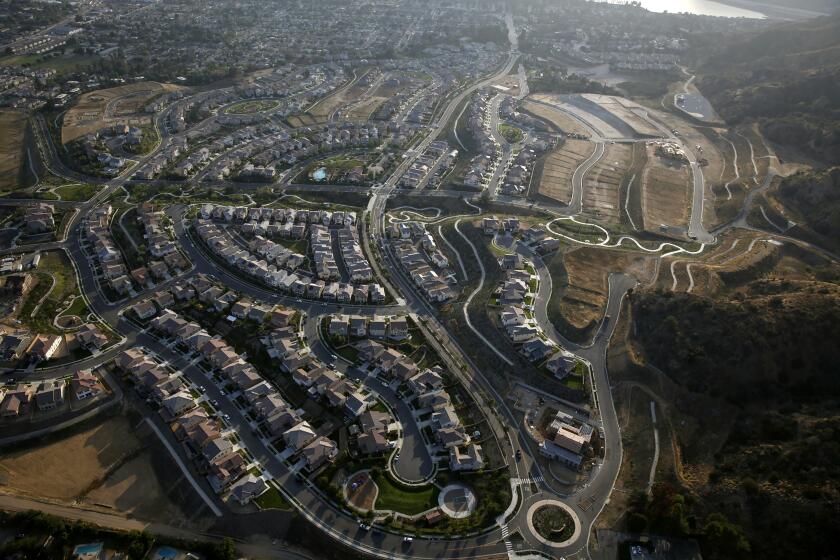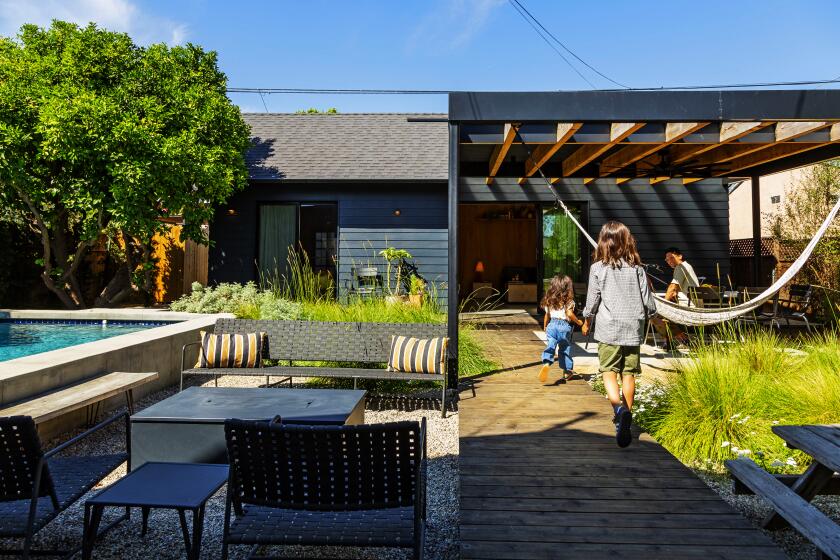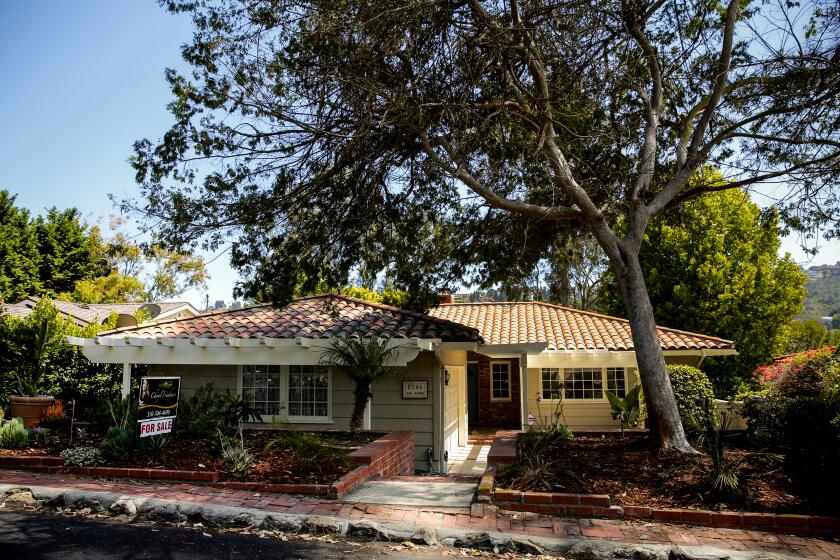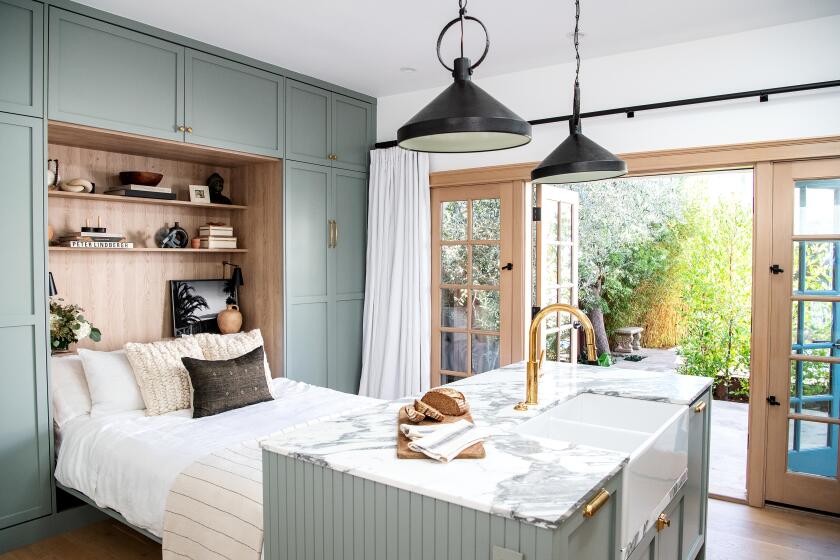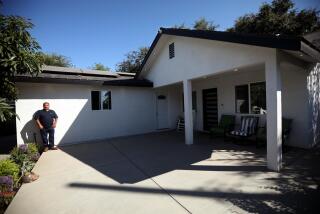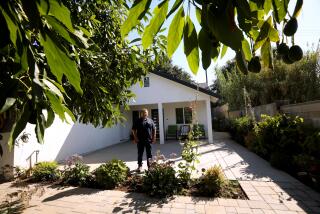A new California housing law has done little to encourage building, report says
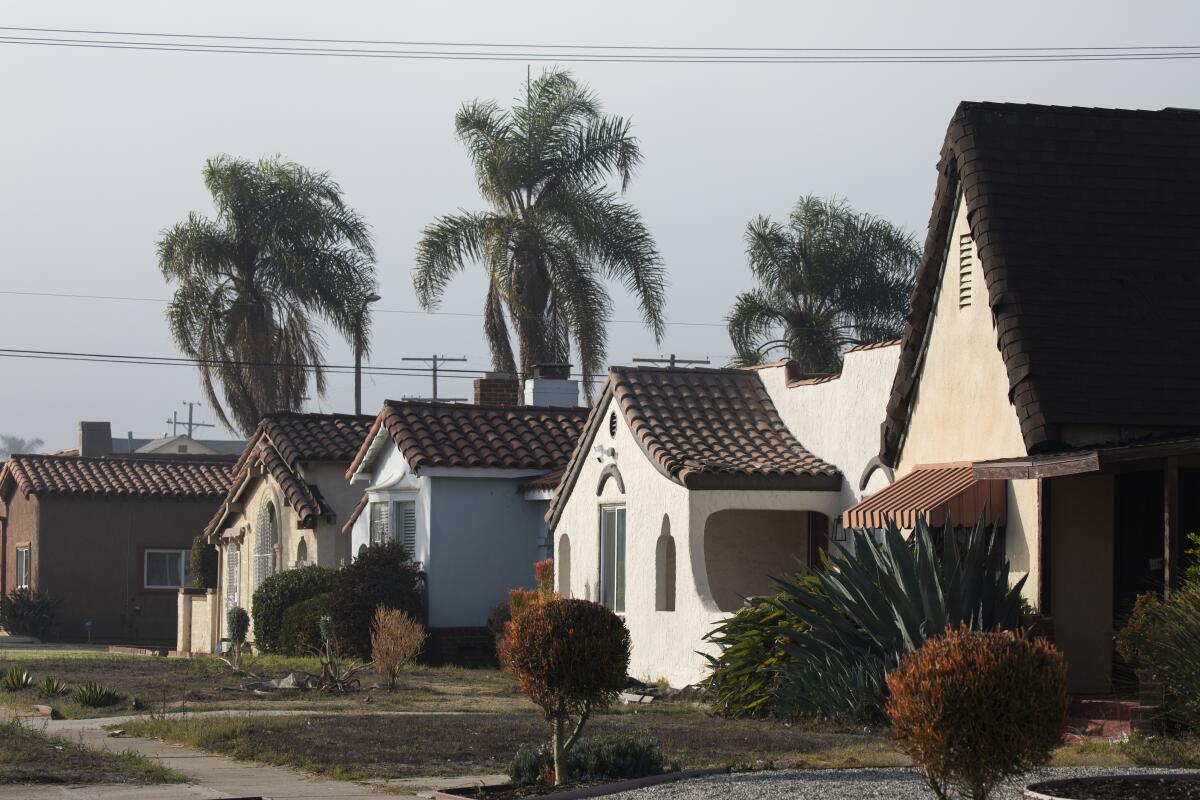
- Share via
Once seen as the death knell for single-family-home neighborhoods in California, a new law meant to create more duplexes has instead done little to encourage construction in some of the largest cities in the state, according to a new report published Wednesday.
Senate Bill 9 was introduced two years ago as a way to help solve California’s severe housing crunch by allowing homeowners to convert their homes into duplexes on a single-family lot or divide the parcel in half to build another duplex for a total of four units. The law went into effect at the start of 2022.
The bill received bipartisan support and ignited fierce debate between its backers, who said SB 9 was a much-needed tool to add housing options for middle-income Californians, and critics, who blasted it as a radical one-size-fits-all policy that undermined local government control.
Neither argument has so far proved to be true.
Across 13 cities in the state, SB 9 projects are “limited or nonexistent,” according to a new study by the UC Berkeley Terner Center for Housing Innovation.
The report focused on cities considered high-opportunity areas for duplexes because they’ve reported significant increases in the construction of accessory dwelling units — also known as granny flats, casitas or ADUs — in recent years and have available single-family properties for possible divided lots. ADUs are small, free-standing homes most often built in the backyards of existing single-family homes.
The cities are Anaheim, Bakersfield, Berkeley, Burbank, Danville, Long Beach, Los Angeles, Sacramento, San Diego, San Francisco, San Jose, Santa Maria and Saratoga.
By the end of November, the cities had collectively received 282 applications for SB 9 projects, and had approved only 53. Los Angeles accounted for the bulk of applications with 211 submitted and 38 approved, according to the report. San Francisco received 25 applications and had approved four, while San Diego received seven and had approved none.
Three cities received one application, and in Bakersfield, Danville and Santa Maria, zero were submitted.
Applications for dividing lots seem to be even less popular than for building duplexes. Just 100 applications were submitted, the report noted, and 28 had been approved.
Gov. Gavin Newsom signed legislation that allows more than one unit to be built on lots zoned for only one. It sounds technical, but it’s a major change in California housing policy. Here’s what it means.
David Garcia, Terner Center’s policy director, said SB 9 is only in its first year of implementation and should be given more time before it’s judged as ineffective. But he added that lawmakers should consider whether the law needs tweaking.
“It doesn’t seem like Senate Bill 9 in its first year has resulted in very meaningful amounts of new housing,” Garcia said. “Pretty much everywhere you look, Senate Bill 9 activity is very marginal. It is nonexistent in some places.”
Homeowners right now have an easier time building an ADU than a duplex, thanks to local and state laws that have eased barriers to construction in recent years, Garcia said. It took multiple rounds of legislation to see productive ADU development, and the same will probably be true for SB 9 projects, he said.
Recognizing that more was needed to speed up housing construction in California, the Legislature began overhauling state ADU laws in 2016, and cities followed suit with their own local ordinances to clear red tape in the building process, which has inspired a widespread ADU movement.
Between the start of 2017 and January 2023, the city of Los Angeles reported receiving 35,098 applications for ADUs. It has issued permits for 25,881 and 13,640 have been granted certificates of occupancy.
Homeowners and architects share some of the lessons they learned in building an accessory dwelling unit, or ADU, on single-family lots in Los Angeles.
Heidi Vonblum, San Diego’s planning director, said the law is new and barriers to development are still being worked out. At the same time, the city has an ADU program that “has been very attractive to property owners,” Vonblum said, while updated zoning rules and community plans have eliminated “the need to rely on other programs.”
It’s a similar situation in Sacramento, where homeowners are allowed to build up to two ADUs on their properties, said Kevin Colin, the city’s zoning administrator. Colin’s team handles one to two ADU applications “each working day,” he said, because there’s such high interest in the projects.
To replicate that success, the Terner Center report suggested cutting fees associated with new duplex development, or adding more uniform standards for SB 9 projects to ensure local governments can’t attach subjective criteria that discourage applications, such as architectural design requirements or stringent landscaping rules. It also proposed revising a mandate that homeowners who split their lots must live in one of the units for at least three years, a key concession lawmakers made to reduce opposition from organizations worried about gentrification.
Senate President Pro Tem Toni Atkins (D-San Diego), author of the legislation, said SB 9 was “never intended to be an overnight fix to our housing shortage.”
“We always said not every homeowner would be able, or want, to utilize the tools provided by the bill on Day One,” Atkins said in a statement. “Subdividing a lot, or even just adding an ADU, is a big investment. This bill was never intended to be a sledgehammer approach — it was meant to increase the housing supply over time, and as awareness of the law increases and more homeowners have the ability to embrace the tools, I’m confident that we will see results.”
A new UC Berkeley study on Senate Bill 9 is sure to add to the long-running debate on allowing more density on the prized single-family lot.
Garcia and other housing experts said slow progress could also be attributed to the effects of the COVID-19 pandemic, when prices for building materials shot up and homeowners and buyers faced significant market uncertainty. That was followed by high inflation and interest rates.
But other factors could be contributing to sluggish SB 9 interest.
Matthew Lewis, spokesperson for California YIMBY, a housing advocacy organization that supported SB 9, said both ADUs and duplexes have their financial and logistical pros and cons.
ADUs are an ideal way to generate some “passive income” from a renter, Lewis said, and make great homes for aging parents or young adult children. Duplexes are good for that too, but the additional units can be sold separately for even greater economic opportunity.
On the other hand, ADUs are typically a property extension of the main home, so it can be difficult or even impossible to separately sell the extra unit. Duplexes require significantly more financing, and the addition of a separate sewer line and water service.
“The reality is people will follow the path of least resistance to building the house they want,” Lewis said, adding that it could be worth going back to the drawing board to ensure local governments are doing what they can to ease burdens to duplex development.
A 1926 Spanish bungalow has housed this Pacific Palisades family for nearly 30 years. Can a small ADU help shelter them for 30 more?
Although the Terner Center report offers legislators a limited snapshot of how SB 9 has worked so far, the state is also expected to have more robust data available this summer.
Any attempt to modify SB 9 this year, however, is sure to reignite opposition from many of the dozens of cities and neighborhood associations that tried to block its passage in 2021. Since then, some cities have gone to great lengths to avoid implementing the law, including the Silicon Valley suburb of Woodside, which declared itself a mountain lion sanctuary and invited a stern warning for compliance by the state attorney general’s office.
More to Read
Sign up for Essential California
The most important California stories and recommendations in your inbox every morning.
You may occasionally receive promotional content from the Los Angeles Times.
